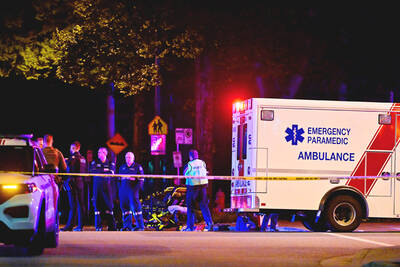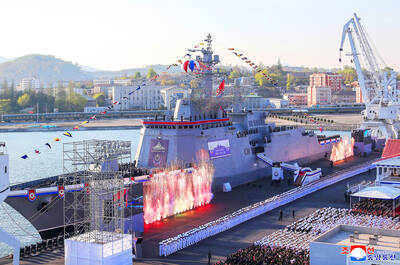The 600 skeletons are packed into fruit cartons and stacked on shelves in the walk-in closet of a forensic lab, in the dim glow of a single bare light bulb. They are "Skeleton No. 4" or "Skeleton No. 21," and nothing more.
But a quarter-century after Argentina's dictatorship and "dirty war" against its own citizens ended, DNA technology raises the possibility of finally learning the identities of these skeletons in the closet, collected from mostly unmarked graves across Argentina.
Anthropologists have launched an ambitious campaign, drawing on techniques pioneered in Bosnia and at New York's World Trade Center after the Sept. 11, 2001, attacks.
On television and radio, celebrities exhort relatives of "the disappeared" to provide blood samples for a nationwide DNA database. A weekday call center advertises its toll-free number on banners at soccer games.
"If you have a family member who was a victim of a forced disappearance ... a simple blood sample can help identify them," says a popular Argentine soccer sportscaster in a TV ad.
The campaign began in November and is already paying off.
"We've received some 2,000 telephone calls," said Luis Fondebrider of the Argentine Forensic Anthropology Team, which was founded in 1984 to document the missing and has since applied its know-how in more than 40 countries, from El Salvador to Iraq to East Timor.
It also led the identification through of Cuban revolutionary Ernest "Che" Guevara's remains, exhumed in the 1990s.
The nonprofit group hopes soon to recruit a US lab to cross-match the samples with DNA from all 600 skeletons in the closet, many of which have bullet holes in their skulls or signs of torture.
Large-scale DNA sampling has become quicker and cheaper since it was pioneered in Bosnia, said Mercedes Doretti, a founder of the group and a recipient of a MacArthur Foundation "genius grant" last year.
After Bosnia's war in the early 1990s, the International Commission for Missing Persons createdea system to conduct sophisticated DNA tests on thousands of exhumed bodies.
After the World Trade Center attacks, US experts expanded the technology, building software to compare thousands of DNA samples simultaneously from the fragments from the Twin Towers.
But Doretti's group did not have the money to use these new technologies for investigations until the US Congress gave it a grant last year of nearly US$1.5 million.
Adding to the urgency of identifying the dead, Argentine President Cristina Fernandez has pushed to speed up trials in hundreds of human rights cases that were blocked by an amnesty for alleged perpetrators. The amnesty was repealed in 2005.
The campaign could also lead to a more accurate death toll from the "dirty war" against leftist opponents by Argentina's 1976 to 1983 dictatorship, and bridge the gap between the more than 12,000 officially listed as dead or missing and the 30,000 estimated by human rights groups.
"We hope there might be more people coming forward, especially in the provinces," to report missing relatives for the first time, said Luis Alen, a government undersecretary for human rights.
In most cases, remains have never been found, and of those recovered by Doretti's group, fewer than 300 have been identified.
The last identification was in 2005, when DNA testing gave a name to remains that years earlier had washed ashore, apparently tossed from a "death flight" in which drugged prisoners were thrown alive into the sea. French nun Leonie Duquet was given an emotional funeral at the Buenos Aires church where she had been abducted in 1977.

Archeologists in Peru on Thursday said they found the 5,000-year-old remains of a noblewoman at the sacred city of Caral, revealing the important role played by women in the oldest center of civilization in the Americas. “What has been discovered corresponds to a woman who apparently had elevated status, an elite woman,” archeologist David Palomino said. The mummy was found in Aspero, a sacred site within the city of Caral that was a garbage dump for more than 30 years until becoming an archeological site in the 1990s. Palomino said the carefully preserved remains, dating to 3,000BC, contained skin, part of the

TRUMP EFFECT: The win capped one of the most dramatic turnarounds in Canadian political history after the Conservatives had led the Liberals by more than 20 points Canadian Prime Minister Mark Carney yesterday pledged to win US President Donald Trump’s trade war after winning Canada’s election and leading his Liberal Party to another term in power. Following a campaign dominated by Trump’s tariffs and annexation threats, Carney promised to chart “a new path forward” in a world “fundamentally changed” by a US that is newly hostile to free trade. “We are over the shock of the American betrayal, but we should never forget the lessons,” said Carney, who led the central banks of Canada and the UK before entering politics earlier this year. “We will win this trade war and

‘BODIES EVERYWHERE’: The incident occurred at a Filipino festival celebrating an anti-colonial leader, with the driver described as a ‘lone suspect’ known to police Canadian police arrested a man on Saturday after a car plowed into a street party in the western Canadian city of Vancouver, killing a number of people. Authorities said the incident happened shortly after 8pm in Vancouver’s Sunset on Fraser neighborhood as members of the Filipino community gathered to celebrate Lapu Lapu Day. The festival, which commemorates a Filipino anti-colonial leader from the 16th century, falls this year on the weekend before Canada’s election. A 30-year-old local man was arrested at the scene, Vancouver police wrote on X. The driver was a “lone suspect” known to police, a police spokesperson told journalists at the

North Korean leader Kim Jong-un has unveiled a new naval destroyer, claiming it as a significant advancement toward his goal of expanding the operational range and preemptive strike capabilities of his nuclear-armed military, state media said yesterday. North Korea’s state-run Korean Central News Agency (KCNA) said Kim attended the launching ceremony for the 5,000-tonne warship on Friday at the western port of Nampo. Kim framed the arms buildup as a response to perceived threats from the US and its allies in Asia, who have been expanding joint military exercises amid rising tensions over the North’s nuclear program. He added that the acquisition